Target-group specific surfaces, sophisticated filter functions, product details at a glance, data flow at the speed of light and 24/7 availability – the digitalisation of buying processes demands well-thought out e-Commerce solutions. Whereby opening up virtual sales and communications channels not only becomes more and more indispensable on the B2C market, but also on the B2B landscape.
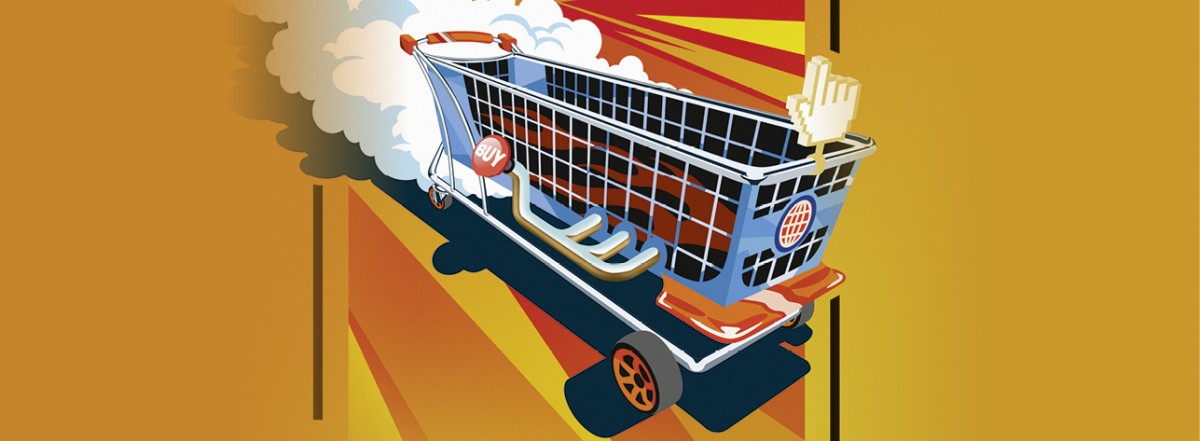
24 years ago Jeff Bezos founded the online mail order business Amazon in Seattle. His vision: Offering the largest possible selection of items. The American entrepreneur has pretty much been achieving this since 1994. Taking a look at the bestsellers that were determined for each country after Amazon Prime Day on July 2017 indicates the extent of the product spectrum. They include a pressure cooker (USA), a soda-stream maker (Germany), protein powder (Japan), a Blue-Ray edition of Game of Thrones (France), a Wi-Fi plug (Great Britain) and dishwasher tabs (Italy). But anyone who is looking for a safety vest for chickens, DVDs with washing machine impressions or pizza scented air-freshener, will find what they are looking for on the platform. An upheaval on the retail market goes hand in hand with the rapid ascent and huge offer of market players like Amazon, Alibaba and co. E-Commerce has become a significant economic factor. In 2017, the global turnover of Amazon totalled around 153 bil. Euros. The Alibaba Group turned over around 768 bil. Euros. The B2B platform Alibaba. com accounted for approx. 39 bil. Euros. The Far East set benchmarks in general: In its Global Ecommerce Report 2017, the Ecommerce Foundation predicted a global e-Commerce turnover of approx. 1.84 bil. Dollars for 2017 (1.59 bil. Euros). The Asian/Pacific region made up the largest share of the turnover with approx. 47% and around 875 bil. Dollars (757 bil. Euros). Europe ranked second with approx. 25% and around 472 bil. Dollars (409 bil. Euro).
Buying behaviour on the web
The consumers can be divided up into three types of buyers: Whereas the “Noroomer” still buys his provisions in retail shops, the “showroomer” selects and tests the products at the POS before purchasing them online. The “webroomer“ on the other hand exclusively makes his purchase decisions per mouse click. The number of showroomers and webroomers is constantly rising, because more and more people are growing up with digital technologies from birth. “The shopping habits and needs of the digital natives have changed. They want to shop round the clock regardless of where they are,” explained Tobias Gottwald of Promostore. “On the web the products and prices can be conveniently compared, one doesn’t have to drive into the city, wait in queues at the cash desk and has the goods delivered home free of charge.”
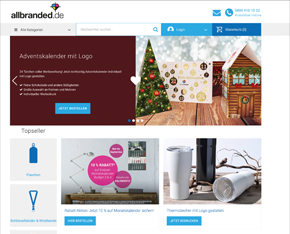
The homepage of the shop is the counterpart to the shop window in the pedestrian zone and has to be regularly updated. Themes such as the seasons, bank holidays or sports events as well as trend items and discount campaigns can be used for the current contents.
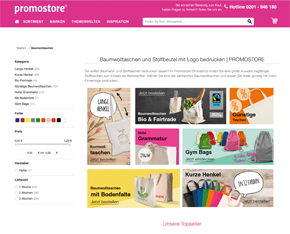
Filter options help the users find the right product fast among the over 80,000 items in the web shop of Promostore. The users can have items shown to them for instance in a certain colour or price range.
Usability in front of and behind the scenes
In those cases where Internet giants like Amazon, Alibaba and co. are calling the shots in the online business and are setting increasingly higher standards, it is essential that the B2B sector keeps up with the B2C standard regarding functions, processes and convenience. 85% of the business people questioned in the course of the ibi research survey named the search function as being the most important function when buying online in a B2B shop. This was followed by the filter functions (47%) and delivery tracking (30%). Beyond this availability overviews as well information on the technical specifications and prices are also important. “The design of the homepage, an intuitive navigation as well as intelligent search and filter options are extremely important and have to be designed in a functional and clear manner,” according to Arne Schubert, allbranded. “The homepage is frequently the first place of contact with the customer. It has to arouse interest and establish trust, convey the key offer in a logically structured manner and intelligently introduce the user to the shop. The search and filter functions are above all important tools for B2B customers, who have a high need for information, in order to find the desired information fast.” In this way, the homepage not only allows entry via product groups, but also via specific theme worlds such as football, sustainability or Christmas. Bestsellers, novelties or discount campaigns are advertised and invite the users to continue surfing. The users can refine their original search using the function options according to certain product characteristics, colours, manufacturers, prices or delivery times and can have the results displayed according to criteria such as popularity, novelty, order volume or highest/lowest price. “The entire architecture of the shop decisively contributes towards the customer finding the right product as fast as possible. The more he has to click, the higher the probability that he will lose patience and break off the ordering process,” stated Gottwald.
At a trade show or customer call cups, T-shirts and co. can be viewed from all sides, touched and tried out. Detailed questions are clarified in a personal dialogue. On the web texts and photos take over this task. Whereby the differences between the items necessitates detailed product descriptions and the careful implementation of strongly differentiated data. Finally, it is not just about the colour, dimensions and weight, but also about storage memory (USB sticks), performance (power banks), sell-by dates (jelly babies), fill volume (hand cream) or sizes (textiles). Furthermore, promotional products distributors that buy from their suppliers need logistic-related information – from the packing options and sizes, to customs tariff numbers, through to the number of items that fit on a palette. Well-processed photos are equally importing: “As a trade representative for 18 high-quality brands we have the advantage that our partners provide us with attractive atmospheric photos. The user should be able to examine the products from different angles and see them in relation to other items. We additionally work with a zoom function and integrate videos,” reported Clemens Hübschmann, mood rooms. “It is a misconception to believe that once you have got the system working, most of the work is done. An online shop is like a living organism that has to be fed daily. Many industry participants underestimate the significance of high-quality photos and complete product data for the online purchasing process.” Schubert: “Lacking data processing standards mean a high amount of manual effort, which takes a lot of time. The focus of the digitalisation activities should lie on the process automation, so that the distributors and suppliers profit from a uniform, automated data processing via interfaces.” Magali Chéchin, European Sourcing, added: “We work very closely together with the over 400 suppliers that are connected to our search platform and have developed a special matrix for the data exchange. This allows us to act efficiently and continually keep our database up-to-date.”

In the mood rooms web shop, high-quality photos and a corresponding categorisation attract attention, invite the user to browse through a website and increase the amount of time the users spend on the website.
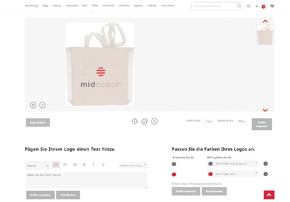
Logos and advertising messages can be placed directly on the desired item on the monitor. In Midocean’s shop the resellers can create valid proofs and forward them on to their customers.
Specific challenges
In addition to the huge variety of products, the individualisability of the items also faces web shop operators with big challenges. Distributors like allbranded and Promostore explain the different printing techniques to the users on extra advisory pages and introduce individual product groups and their customising options in blogs or customer magazines, in order to give the industry customers with little previous knowledge an idea of the subject. Furthermore, some of the market participants have installed web tools with the help of which company logos and texts can be directly placed onto the selected gift online. Others use programmes that allow a print status diagram and immediate price calculation. Stephen Gibson, Midocean: “We have developed a web-to-print tool that enables the reseller to generate his own, valid digital proof within a minute and forward this on directly to his customers. It is not necessary to wait for a graphic designer to complete it. This enables artwork to be created online and printing orders to be placed including the status copy, i.e. the last check of the text, position and photo before the printing plate is produced. Once the customer has approved the digital proof, the order can go into production. This saves a lot of time – and in the Amazon era with their 24-hour delivery guarantee, speed is expected in the business with personalised goods. The fast availability of the items was one of the reasons for us erecting the new factory in Poland. Besides samples orders that leave the same day, print orders are shipped as fast as within 24 hours after approval.” “Especially small volume orders and follow-up orders are increasingly processed exclusively online and using digital approval processes,” added Gottwald. Information on the availability of goods is not insignificant for the pure Internet buying process. As far as the publication of current stocks and the setting up of interfaces in this area goes, the industry isn’t reacting homogeneously. Whereas large importers such as Midocean reveal and convey data and figures, the brand-name companies are more reserved. “Information on the current inventories can indicate how well or how badly an item is selling,” explained Hübschmann. “In order to prevent competitive analyses, brand names tend to be less transparent on the web.”
The web presence of moodrooms targets both the users of haptic advertising and promotional products agencies and demonstrates how dealing with the heterogeneous customer structure within the industry can also work online. Hübschmann: “The individual websites of the companies that we represent target private end consumers. We have positioned the line-up in accordance with the needs of all participants on the promotional products market on the web and we invested a six-digit figure for the purpose. We forward on enquiries from industry customers to the consultants stated on the web form or we recommend an agency. Distributors who own an account approved by us can view more information and can create PDFs containing photos, descriptions, individually adapted industry prices and the distributor logo for their customers within minutes. Thanks to the technical possibilities, it is much faster to pass on suggestions today.” Midocean even makes test reports certificates and conformity declarations for its items available online as additional sales arguments.
In this way, with diversified contents and elaborate tools the industry is proving that the complexity of promotional products orders can be more and more frequently completely covered online. “We already receive most of our ingoing orders online,” reported Gibson. “We assume that this trend will be ongoing over the next years.” And if personal advice is needed, the user contacts the customer service department directly during the opening hours per live chat, e-mail or telephone.
Assistance by professionals
The complexity that the design and maintenance of one’s own web shop entails, faces many industry participants with difficulties. In the case of small and medium-sized companies the digitalisation activities present an obstacle that is almost impossible to overcome due to lacking resources, both in terms of money and staff. Furthermore, the multi-lingual adaption, legal provisions and country-specific tax regulations put many companies off borderless online trading. Chéchin: “The digitalisation is progressing fast in Northern Europe, the Benelux countries and the DACH region. In Italy and Spain and in some cases in France, the companies are still mainly working with catalogues and some companies don’t even have a homepage.” “For me the industry is lacking far-sightedness,” confirmed Gottwald. “The suppliers and consultants have to understand that the Internet is an additional sales channel. Digital channels are taking over the tasks of the external sales team. The business with promotional products will be transacted online more and more in the future, so investments in IT solutions have to be made now.” With a view to the private user behaviour, the adaption of websites to suit different user interfaces is also necessary. Gibson: “Today, the users implement different devices, a fast reacting web shop with a responsive design should therefore be the standard. Since many of our customers do business from the office using the PC, the number of smartphone users is however currently lower than on the B2C market, where surfing per smartphone or tablet is already customary.”
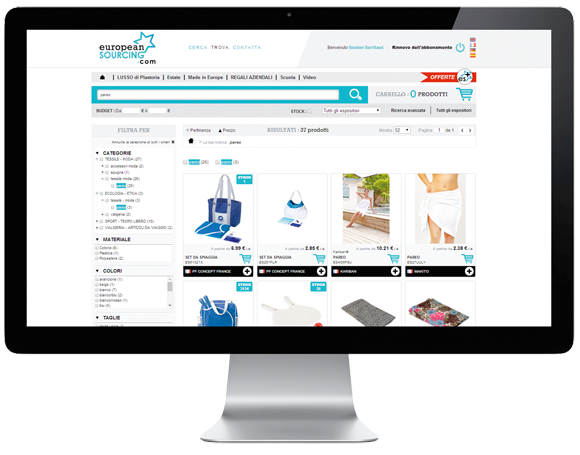
Promotional products players have access to the product ranges of over 400 European suppliers via the search engine of European Sourcing. They can send enquiries via the platform or engage in a direct exchange with the respective sales managers using the displayed contact data.
Several independent suppliers of software applications and data services have established themselves on the market such as European Sourcing, Promidata or CDH for instance, who support the less web-savvy players of the promotional products industry with their online selling and sourcing activities. “We make the necessary digital tools available to the manufacturers and distributors that upgrade their sales or communication strategies on the web,” explained Chéchin. “A uniform search platform with products of suppliers from all over Europe simplifies the research work of the distributors. Suppliers use our database to increase their export activities. Novelties are distributed much more quickly because we not only enter them into our B2B search engine, but also transmit them to the web shops of the agencies that use our MyEasyWeb offers via an automated process. These are individual shop solutions with especially adapted functions and own designs. The consultant selects the product range offered in the shop and determines the sales prices.” However, without marketing measures the most sophisticated web presence doesn’t yield any turnover. “There is no traffic without communication work. Our MyEasyWeb pages are onpage-optimised to achieve a better Google ranking. Creating new contents regularly also increases the organic reach. Distributors should additionally promote their online sales channel using newsletters, banner advertisements and social media marketing.” “Being found on the web is extremely important,” added Schubert. “We mainly use the Internet for our marketing activities. We work with a large set of keywords and enhance our SEO measures by using SEA measures such as Google AdWords and Bing Ads, in other words we book exclusive spots within the search engine results pages.”
A holistic approach
Establishing long-term customer relations also plays a key role in the e-Commerce business. Schubert: “Attractive offers and campaigns that centre on the user returning, reinforce the customer loyalty. The users expect more and more frequently offers that are tailor-made to suit their needs. In addition to convenient ordering and payment processes these also include personalised buying experiences, among others with customer- specific interfaces, price lists and payment options. Video contents and voice purchases are further e-Commerce trends. As a result of the constant development of the online consulting offer, the need for personal contact will continue to decrease.” The forecast of the experts of the Regensburg ibi research survey is that the classic sales channels won’t disappear as a result, but will indeed lose relevance. Gibson believes in a shifting of the contents of the external sales force: “Personal contacts remain important for customer relations and to reinforce business relations. The only thing that will change is that in the direct exchange we will have to focus more on the realisation of the individual requirements of our customers.” Last, but not least big orders, custom- made designs and concrete campaign planning cannot be taken care of digitally as yet. The joint development of ideas is difficult to transform into bits and bytes. Chéchin: “Professional agencies develop creative ideas, realise exciting campaigns and make recommendations that go far beyond the usual standard goods – this is still only possible in the direct exchange.”
In September Amazon opened its third Amazon Go-Shop in Seattle. On entering the fully -automated food shop, the customer logs in per app. Sensors register which and how many items he take from the shelf; the shopping costs are automatically booked from the Amazon account on leaving the shop. In this way, an online giant like Amazon is placing its bets on the bricks and mortar trade and on multi-channel selling strategies. So why not rely on a multi-channel approach in the promotional products industry too? Because companies that transfer their offline activities into the online world can do good business – and the odd new customer will no doubt also be delighted to get a personal customer call.
// Jasmin Oberdorfer
Illustration: Jens C. Friedrich, © WA Media; screenshots www.allbranded.de, www.europeansourcing.com, www.midocean.com, www.mood-rooms.de, www.promostore.de



